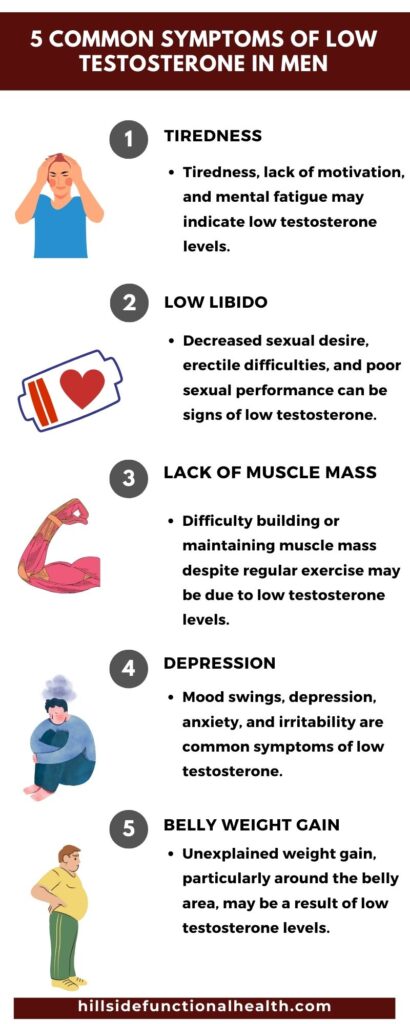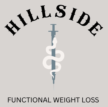Testosterone Replacement Therapy (TRT) raises a big question: when should one start? Are symptoms suggesting low testosterone levels troubling you? Are you aware of the guidelines for starting treatment?
This article will look at the upsides of TRT when to consider it, and who should consider it. All to help decide the best time for this treatment that could alter your life. When it comes to Hillside’s Testosterone Therapy Baytown TX, we carefully consider the symptoms, timing, and guidelines for starting treatment to ensure optimal results. Let’s discuss what this treatment method is and when you should get it:
What is Testosterone Replacement Therapy (TRT)?
Testosterone replacement therapy (TRT) is a treatment that involves supplementing the body with external sources of testosterone, typically prescribed for men diagnosed with low testosterone levels or hypogonadism. The frequency and duration of TRT depend on various factors, including the individual’s age, overall health, the severity of symptoms, and the method of administration.
TRT is often administered continuously for optimal results, as the goal is to maintain stable and physiologically normal testosterone levels in the body. Here’s a general overview of the frequency of different administration methods:
- Injectable testosterone: This is one of the most common forms of TRT. Short-acting injections are administered every 1-2 weeks, while long-acting injections are administered every 8-14 weeks. The frequency may vary based on the individual’s response and blood testosterone levels.
- Transdermal gels or patches: These are applied daily, either on the skin or the upper gum area. Consistent daily application is crucial to ensuring stable testosterone levels.
- Testosterone pellets are small pellets inserted under the skin, typically in the hip or abdominal area. The pellets release testosterone gradually, and the procedure is generally repeated every 3-6 months.
It’s important to note that TRT is not a one-size-fits-all treatment. The dosage and frequency are tailored to each individual’s needs, and regular monitoring of testosterone levels, as well as potential side effects, is essential. For example, if a man’s testosterone levels remain low despite adhering to the prescribed regimen, the dosage or frequency may need to be adjusted.
Let’s consider a 55-year-old man diagnosed with hypogonadism. His doctor may initially prescribe intramuscular injections of testosterone cypionate, administered every two weeks. After a few months, the doctor may evaluate the patient’s response, check his testosterone levels, and adjust the frequency or dosage. If the patient prefers a more convenient option, the doctor may consider switching to a transdermal gel, which the patient would apply daily.
It’s worth mentioning that Hillside’s Testosterone Therapy Baytown TX is a reputable provider of TRT services in the Baytown, Texas area, offering personalized treatment plans and close monitoring for individuals seeking testosterone replacement therapy.
How Do You Know If You Need TRT? 5 Symptoms in Men:
TRT can be beneficial for men with low testosterone levels. Wondering if you need it? There are clear signs you should be looking out for.

Tired, Lazy and Fatigued:
If you’re always feeling tired and unmotivated, it could mean your testosterone is low. Even if you sleep well, you might still feel drained. You might not feel like doing activities or hobbies you used to love. You could also struggle with mental tiredness and difficulty thinking clearly.
Feeling this way might mean it’s time to consider Testosterone Replacement Therapy (TRT). TRT can help bring your testosterone levels back to normal, which can help with the tiredness, lack of drive, and low energy you’re facing. With TRT, you may feel more energetic and motivated, and your overall well-being could improve, too.
Decline in Sexual Desire:
Low testosterone can lead to less sexual desire, hard times getting or keeping erections, and poorer sexual performance.
If you’re less interested in sex, struggle with erections, or see a drop in how you perform sexually, talking to a doctor about Testosterone Replacement Therapy (TRT) could help.
Difficulty Building or Maintaining Muscle Mass:
Low testosterone makes it hard to build and maintain muscle. Even if you work out a lot, you might not see the muscle growth you want. Plus, it can make you weaker, making once-easy tasks harder.
If working out hard but still struggling to build muscle, or if you’re getting weaker, TRT might help. It boosts your testosterone levels, helping with muscle growth and better performance. It gives your body the testosterone it needs, helping you get leaner muscles.
Along with TRT, a healthy lifestyle is important for muscle and strength. Eat a protein-rich diet, do strength training, and get plenty of rest. These are all key to building muscle.
Key points about low testosterone and muscle:
- It can stop you from growing and developing muscle.
- TRT boosts testosterone levels and helps with muscle growth.
- TRT, diet, exercise, and rest can all improve muscle and strength.
With TRT and the right lifestyle, you can overcome the challenges of muscle building and regain your strength and muscle mass.
Depression, Anxiety, Irritability:
Low testosterone can cause mood swings and feelings of depression and anxiety. It also causes irritability and makes it hard to focus. If you feel down, anxious, or irritable more often, or if concentrating on tasks is a struggle, it might hint that you could benefit from Testosterone Replacement Therapy (TRT).
| Symptoms: | Potential benefits of TRT: |
| Increased feelings of depressionAnxietyIrritabilityDifficulty concentrating | Stabilized moodReduced symptoms of depressionImproved cognitive functionBetter concentration and focus |
Treating low testosterone with TRT could help improve your mood, emotional health, and brain functions. It’s key to talk to a doctor who can keep an eye on your hormone levels and see if TRT is right for you.
Unexplained Weight Gain:
Low testosterone can lead to weight gain around the belly and more body fat. Seeing weight increase, especially in the belly area, is a warning sign.
If this happens, and you can’t lose weight despite healthy habits, it might be low testosterone. Treating it with Testosterone Replacement Therapy (TRT) may help balance your levels.
If your testosterone is low, burning fat becomes harder. This can make belly fat pile up more easily.
| Before TRT | After TRT |
| Increased body fat percentage | Reduction in body fat percentage |
| Slow metabolism | Enhanced metabolism |
| Difficulty losing weight | Improved weight management |
Alongside TRT, eating well and exercising can also help you lose weight and feel better.
Here are some key points to consider:
- Low testosterone can lead to unexplained weight gain.
- Excess weight, especially around the midsection, can indicate low testosterone.
- TRT may help with weight issues by getting testosterone back to normal.
- Healthy habits like exercise and balanced diet aid in losing weight.
What Causes Low Testosterone Levels?
Testosterone is key for men’s health. It affects muscle mass, sex drive, mood, and energy. But what leads to low levels of it? Could it be just aging, or is something else involved? We’ll look into what causes this issue and its effect on health.
Natural testosterone declines as men get older over time
Men’s testosterone levels naturally fall as they get older, and these levels drop about 1% each year. This can cause tiredness, a lower interest in sex, and less muscle mass.
Because of this, older men might need Testosterone Replacement Therapy (TRT). TRT can bring testosterone levels back to normal, help reduce low testosterone symptoms, and boost well-being.
Imagine you’re a 45-year-old man feeling tired, with less interest in sex and weaker muscles. This might be due to lower testosterone. Talking to a doctor about TRT could help improve your life.
| Metric | Age 19 | Age 40 |
| Mean Total Testosterone (nmol/L) | 15.4 | 13.0 |
| 2.5th – 97.5th Percentile Range (nmol/L) | 7.2 – 31.1 | 6.6 – 25.3 |
The key points are:
- At age 19, the mean total testosterone level peaks at 15.4 nmol/L, with a range of 7.2 to 31.1 nmol/L covering the 2.5th to 97.5th percentiles.
- By age 40, the mean total testosterone level has fallen to 13.0 nmol/L, with a range of 6.6 to 25.3 nmol/L covering the 2.5th to 97.5th percentiles.
- There is an approximately 1% per year decline in testosterone levels from age 19 to age 40.
- After age 40, the research paper finds no further statistically significant decline in mean testosterone levels with increasing age.
Being Overweight or Obese
Having extra weight, especially around your belly, can lower the body’s testosterone. Because of this, our bodies can turn testosterone into estrogen, causing a hormone imbalance. When testosterone drops, it negatively affects our health and happiness.
Losing weight can boost your testosterone. This means eating healthy and exercising regularly. You should eat lots of lean proteins, fruits, veggies, and whole grains. Also, cut down on processed snacks and sugary drinks.
Exercise helps too, not just diet. Try doingcardio for weight loss along with strength training to build muscle, and balance hormones.
Achieving a healthy weight can improve your testosterone levels. It lowers the risk of health problems and boosts your overall health.
Prolonged High-Stress Levels:
Chronic stress affects the amount of testosterone your body makes. It disturbs the balance of testosterone and cortisol, a stress hormone.
When you’re stressed for too long, your body makes more cortisol. This makes less testosterone. Low testosterone levels can cause problems with both your body and mind.
Feeling stressed all the time? It’s key to manage that stress. Doing so helps balance your hormones. Try relaxation methods such as deep breathing, meditation, or mindfulness. These can lower stress.
Lifestyle changes also help reduce stress. Eat healthily, exercise regularly, and get enough sleep. These steps support your body’s testosterone levels, too.
Specific Health Issues and Testicular Injuries:
Some health problems, like diabetes, obesity, and chronic diseases, affect the amount of testosterone your body makes. Injuries to the testicles can also lower testosterone production. When this happens, Testosterone Replacement Therapy (TRT) might be needed. TRT helps bring testosterone levels back to normal and eases symptoms.
People with diabetes often have less testosterone. This is because insulin resistance and inflammation hurt the testicles. If someone is obese, their extra body fat can mess with hormones. This often leads to less testosterone being made.
Long-lasting illnesses, such as kidney or liver problems, can also lower testosterone. These diseases mess with how hormones are controlled, causing testosterone levels to drop and leading to the need for TRT.
Also, injuries like orchitis or testicular cancer can directly harm testosterone production. Any harm to the testes can damage the cells that make testosterone. This means TRT might be needed to get hormone levels right again.
Lack of Exercise, Excessive Alcohol, and Poor Nutrition
Not moving enough, drinking too much alcohol, and eating poorly can lead to low testosterone. To keep your testosterone levels up, it’s important to:
- Engage in regular exercise: Do cardio and strength training to help make more testosterone.
- Practice moderation in alcohol consumption: Drinking a lot of alcohol can mess up testosterone production. Keep drinking low to keep hormones balanced.
- Adopt a balanced and nutrient-rich diet: Eat foods rich in zinc, vitamin D, and healthy fats. These are vital for making testosterone.
To maintain healthy testosterone levels, exercise often, drink alcohol in moderation, and eat well. These steps will support your overall health, too.
7 Key Benefits of Testosterone Treatment Therapy
Often, men with severe low testosterone symptoms seek TRT. But mild symptoms can also hurt your life and well-being.
If you have any low testosterone signs, TRT might be good to balance your hormone levels and enjoy its many advantages.
Increased Energy, Stamina, and Motivation
Testosterone Replacement Therapy (TRT) could increase your energy and stamina and make you more motivated for daily tasks.
TRT might help you feel more alive. You could find more joy in chores and hobbies. It makes the day’s challenges seem easier.
- TRT can give you the power for regular workouts, which help with weight, heart health, and muscle strength.
- It can boost your stamina, so you can do activities longer without getting too tired.
- Also, TRT may make it easier for you to pursue your goals and keep up with your routines.
Improved Sexual Function
Testosterone is key for sexual desire and ability. Low levels can hurt these functions. Testosterone Replacement Therapy (TRT) can boost sexual health and intimate experiences.
| Benefits of TRT on Sexual Function | Examples |
| Increased sexual desire and libido | Feeling a renewed interest in sexual activities and experiencing a higher sex drive. |
| Improved ability to achieve and maintain erections | Being able to achieve and sustain firm erections for a satisfactory sexual experience. |
| Enhanced overall sexual performance | Feeling more confident in one’s ability to please one’s partner and enjoy sexual experiences. |
Getting the right testosterone level with TRT can make sexual health better. This leads to a happier and more satisfying intimate life.
Enhanced Muscle Strength
Testosterone Replacement Therapy (TRT) greatly helps improve muscle strength, tone, and lean mass. Testosterone is key for muscle growth. With optimized levels through TRT, individuals see big improvements in strength and appearance.
TRT boosts testosterone levels, enhancing protein synthesis, which is important for muscle growth. It also boosts red blood cell production. This helps bring more oxygen to muscles, helping them grow and last longer.
TRT offers many benefits for those wanting to better their physique and athletic abilities. TRT can improve muscle strength tone and help build lean mass:
- Increased muscle protein synthesis, allowing for faster muscle growth and repair
- Enhanced muscle recovery, reducing fatigue and allowing for more frequent and intense workouts
- Improved muscle density and definition, resulting in a more toned and sculpted appearance
- Increased muscle strength, allowing for greater power and performance during physical activities
- Enhanced endurance, enabling individuals to engage in longer and more intense training sessions
- Greater ability to build lean mass, resulting in an increase in overall muscle size and volume
While TRT has great benefits for muscle development, it’s best paired with a good diet and regular exercise. Talk to a health pro or a certified fitness coach. They can help create a workout and diet plan to get the most out of TRT.
Reduced Body Fat
Testosterone Replacement Therapy (TRT) has a big perk: it might cut down body fat and boost metabolism. Testosterone is key for fat metabolism. With optimized testosterone from TRT, your body may burn fat better.
Studies show TRT can positively change body shape by cutting down hard-to-lose midsection fat. This kind of fat is around the belly and organs. Reducing it with TRT could improve your shape and lower your health risks.
TRT can also increase your lean muscle. Muscles burn more of your calories than fat, so more muscle means a better metabolism. This can make your body use more calories, even when resting.
| Benefits of TRT | Examples |
| Reduction in body fat | – Decrease in waist circumference- Visceral fat reduction |
| Improved metabolism | – Increase in basal metabolic rate- Enhanced calorie expenditure |
| Increased lean muscle mass | – Improved muscle tone and definition- Enhanced physical performance |
Stabilized Mood
Testosterone is key for controlling mood and brain function. Low levels can cause mood swings and memory issues. Testosterone Replacement Therapy (TRT) may stabilize mood and help with depression and cognition.
TRT works by bringing testosterone levels back to normal. This improves emotional well-being and mental focus. It reduces sadness, irritability, and anxiety, leading to a more stable mood and better mental health.
- Reduced symptoms of depression
- Enhanced mood stability
- Improved cognitive function and memory
- Increased mental clarity and focus
Imagine waking up feeling upbeat and ready to tackle the day with a clear mind. TRT can help you feel this way, giving you emotional balance and better focus.
Strengthened Bone Density
Testosterone is key in keeping bones strong. With Testosterone Replacement Therapy (TRT), men with low testosterone can get better bone health. This also lowers their chances of getting osteoporosis.
Osteoporosis makes bones weak and brittle, leading to more fractures and injuries. It mostly hits older people, especially women, after menopause. But men can get it, too, especially if they have low testosterone levels.
With TRT, testosterone levels are brought back to normal. This makes bones stronger and more durable, which helps them support the body better and stay healthy.
| Benefits of TRT for bone health: | |
| 1. Increased bone mineral density | • Reduced risk of fractures and injuries |
| 2. Enhanced bone strength and support | • Improved overall bone health |
| 3. Decreased risk of osteoporosis | • Better skeletal structure |
Overall Improvements in General Health
Testosterone Replacement Therapy (TRT) helps boost overall health and quality of life. By getting your testosterone levels right, you can feel better in many ways. This can make you feel more alive and full of energy.
Increased energy means less tiredness. You’ll likely feel happier and more stable mentally, and your sexual desire and function may improve, too.
It helps build stronger muscles and improves physical performance. You might lose some extra fat, and your body could work better. You’ll also notice better focus, memory, and concentration.
Thanks to these changes, you might find life more rewarding. You’ll be ready to enjoy hobbies, relationships, or everyday activities more. TRT can truly help you live life to its fullest.
How Long Do You Need to Take TRT?
The time you need on Testosterone Replacement Therapy (TRT) depends on you, but it is typically done every 2-14 weeks for as long as you achieve and maintain healthy testosterone levels. Consulting a medical expert is key. They look at your symptoms, testosterone levels, and health.
The healthcare provider will understand your needs and goals at your first meeting. They might suggest trying TRT for a bit to see how it works. They can then see if TRT works well for you through regular checks, follow-up visits, and blood work.
TRT often involves ongoing treatment. Yet, how long it lasts changes with each person. Some folks might use TRT forever to keep their testosterone right and symptoms in check. Others might see their levels even out over time, allowing for smaller doses or stopping TRT with a doctor’s okay.
Listening to your healthcare provider about how long to use TRT is crucial. They will track your progress and tweak things as needed. This ensures TRT works best for you safely over time.
Let Hillside Functional Weight Loss & Testosterone Therapy Baytown TX, Help You Maintain Healthy Lifestyle:
If you’re struggling with low testosterone levels and the associated symptoms, don’t hesitate to consult the expert team at Hillside’s Testosterone Therapy Baytown TX clinic.
Our personalized approach, cutting-edge treatments, and regular monitoring can help restore your vitality and overall well-being.



